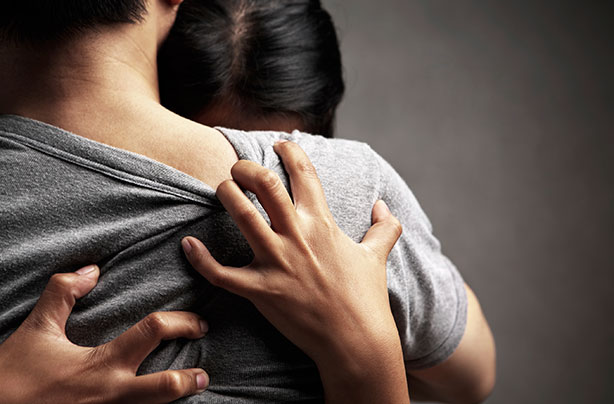Stillbirth: What happens when your baby is stillborn
From causes to what happens during labour, this is everything you need to know about stillbirth

There are more than 3,600 stillbirths every year in the UK and, sadly, one in every 227 births ends in a stillbirth.
In fact, 10 babies are stillborn every day in the UK, yet it remains a topic that's not often discussed openly.
Becoming one of these statistics is something every expectant mum dreads, and for those affected, dealing with the loss of a baby is a completely devastating experience.
People deal with stillbirth in different ways, so whether it's something that you yourself are going through, or if someone you know is, it's important to know the facts around about what happens when a baby is stillborn and the help and support out there.
What is stillbirth?
Stillbirth is when a baby dies at or after 24 completed weeks of pregnancy. If the baby dies before 24 completed weeks, it's known as a miscarriage. Stillbirth can happen during pregnancy, or sometimes (and less often) during labour or birth.
Although not as common as miscarriage, stillbirth is more common than many people think, and can happen for different reasons.
What causes stillbirth?
According to the NHS, around half of all stillbirths are linked to placental complications, which means the placenta isn't functioning properly.
GoodtoKnow Newsletter
Parenting advice, hot topics, best buys and family finance tips delivered straight to your inbox.
Around 10% of stillborn babies have some kind of birth defect, while a small percentage of stillbirths could be attributed to the mum's health.
Pre-eclampsia Pre-eclampsia is a condition that causes high blood pressure in mums to be, which can mean a reduction in blood flow to the baby via the placenta.
Placental abruption This is where the placenta separates from the womb before the baby is born, and may be associated with bleeding or abdominal pain.
Infection Infections can weaken the bag of membranes around the baby, cause an infection inside the womb or make the waters break. Mums-to-be should tell a doctor or midwife about any vaginal discharge that may smell or be any colour other than white, as it could be a sign of an intrauterine infection (an infection within the womb).
Diabetes If a mum has diabetes, stillbirth is more common, so good control of blood sugar levels and close monitoring is vital.
Genetic physical defect in the baby It's thought that a genetic or chromosomal defect causes 10% of stillbirths, which can mean that a baby's brain, heart or another vital organ has not developed properly.
Problems with the umbilical cord According to the NHS, the umbilical cord can slip down through the entrance of the womb before the baby is born (known as 'cord prolapse'), or it can be wrapped around the baby and become knotted.

What puts mums at greater risk of stillbirth?
There are some factors that may mean a mum is at a greater risk of stillbirth. It's important to note that being a healthy weight before pregnancy, eating a healthy diet and speaking to a health professional about the best ways to to avoid infections can all lower the risk. Other factors that may put mums at a greater risk are:
- Twins or a multiple pregnancy
- A baby who doesn't reach their growth potential in the womb
- Being over 35 years of age
- Smoking, drinking alcohol or misusing drugs when pregnant
- Being obese
- A pre-existing physical health condition such as epilepsy
What happens during a stillbirth?
If it's suspected that a baby has died during pregnancy, medical staff will use a handheld device or an ultrasound scan to check the baby's heartbeat.
If the baby has sadly passed away and there's no immediate risk to the mother's health, they'll be given time to think about what they want to do next. The loss of a baby will of course come as a great shock, which is why doctors will be on hand to help and advise the mum on what's best for her.
When a baby dies in the womb, mums still have to go through with the birth, as it's better for her health and physical recovery. It's rare for a stillborn baby to be born by caesarean section unless there's a medical reason.
In most cases labour is induced, but doctors will give the mum time to either wait a day or two, or begin the process straight away if she wishes. Again, if the doctor believes there's a risk to the mum's health, then the induction will begin straight away.
Whether it's a natural or induced labour, the hospital will provide a private room and the midwife or doctor will give the mum morphine-based pain relief, which can be controlled through a pump.
It's rare for a baby to die unexpectedly during labour or birth, but this can occur when the baby's flow of oxygen is cut off. A baby's shoulders may get stuck while leaving the birth canal, or there may be a problem with the umbilical cord (slipping through the cervix before the baby or getting wrapped around the baby's neck).
What happens after a stillbirth?
What happens after a stillbirth is completely up to the parents. Many parents will want to see and hold their baby and will be given some quiet time to do so, while others prefer not to.
Some may wish to take photos of their baby and collect mementos, such as a lock of hair, foot prints or hand prints, or maybe the blanket that their baby was wrapped in.
If parents aren't sure about taking mementos home, they can usually be stored with their hospital records and accessible if and when they want to see them. Some also name the baby, or choose to wash and dress them depending on when the baby passed away and how fragile they are.
There is no right or wrong to respond after experiencing a stillbirth, and anything that happens after the birth is personal and up to the parents.
How can you prevent stillbirth?
Be aware of your baby's movements
During the 16th and 22nd week of pregnancy, expectant mums will begin to feel their baby move. They may become aware of a particular pattern as the weeks go by - for example, their baby may move more in the evenings, or before mum goes to bed.
By 28 weeks, these movements usually become regular, and recognising a pattern is important.
If mums notice a change or reduction in their baby's movements, they need to contact their midwife or maternity unit immediately - do not wait until the next day.
Other factors which may help prevent stillbirth
- Stopping smoking
- Avoiding alcohol and drugs during pregnancy
- Attending all your antenatal appointments so that midwives can monitor your baby
- Ensuring you're a healthy weight before trying to get pregnant
- Protecting yourself against infections and avoiding certain foods
- Reporting any tummy pain or vaginal bleeding to your midwife straight away
What does stillbirth mean for my next pregnancy?
According to stillbirth and neonatal death charity Sands, there is 'no clear-cut evidence about the best time to try for another baby.' Physically, it's advised to wait until any scars (for example, from a caesarean section) are completely healed, the mum's vagina is completely healed, and the cervix (the neck of the womb) is closed again.
According to Sands, it's also important for the mum to discuss things with her doctor if she was ill during the last pregnancy or after the birth, if she had a caesarean, or if the baby who died had a genetic disorder or another condition that might affect a new baby.
However, they do note that feeling ready to try to get pregnant again can differ for a couple, with one partner possibly wanting to try straight away while the other may prefer to wait.
I'm having difficultly coping with a my stillbirth, where can I find help?
People cope with the loss of a baby in different ways, and it might be that a bereaved mother and father cope differently to each other. However, it's important to remember that there is no right or wrong reaction.
We'd advise contacting Sands for help and advice, who can also put parents in touch with other parents who can offer support and information.
Parents can always speak to their midwife or doctor about support too.